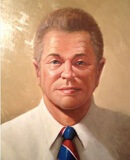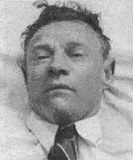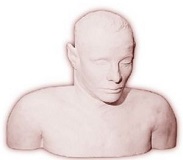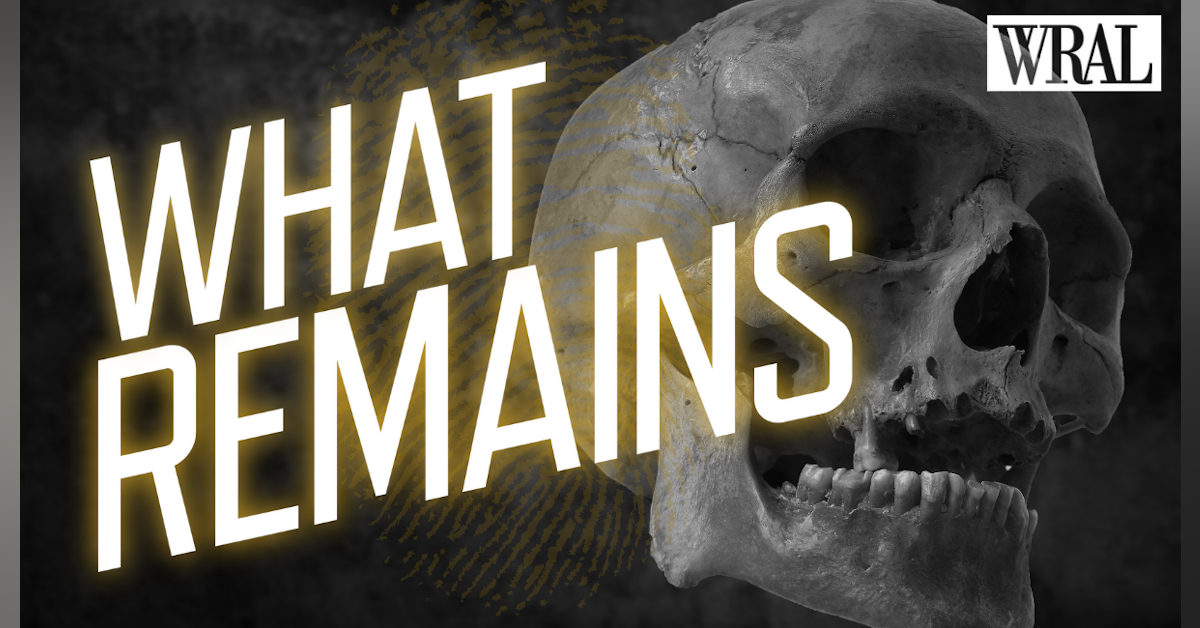2602UMSAU - Unidentified Male




Artistic rendering, photo, and plaster cast of the decedent; Tie similiar to the one the decedent was wearing (US stripes)
Date of Discovery: December 1, 1948
Location of Discovery: Somerton, Adelaide, South Australia
Estimated Date of Death: Probably within 24 hours of being found
State of Remains: Recognizable
Cause of Death: Unknown
Physical Description
Estimated Age: 40-45 years old
Race: White
Gender: Male
Height: 180 cm or 5'11"
Weight: 80 kg or 176 lbs. (estimated)
Hair Color: Mousy colored with red flecks and graying on the sides and back behind the ears.
Eye Color: Gray
Distinguishing Marks/Features: Pronounced calf muscles high up the leg. Three small scars inside the left wrist; one scar inside his left elbow, curved and about an inch long; and one scar or boil mark about an inch in size on the upper left forearm.
Identifiers
Dentals: Available. (Originial handwritten dental chart by the pathologist in 1948)
Fingerprints: Available.
DNA: Sample submitted - tests not complete. It has been determined that his maternal haplogroup is H.
Clothing & Personal Items
Clothing: A white shirt, a striped red/white/blue tie (with slope of stripes following the U.S. convention), brown knitted V-neck pullover, light brown double-breasted jacket (US made), brown pants, brown socks, and brown shoes. All tags were removed from the clothing. The shoes appeared to be bespoke and had the cobbler's last number embossed on the inside leather: "206B."
Jewelry: None
Additional Personal Items: The man had no money in his pockets but did have a small piece of printed paper was found deep within a fob pocket inside of the victim's pants, which read "Taman Shud" that means "ended" or "finished" in Persian. It was found that this piece of paper had been ripped out of the last page of a rare Edward FitzGerald circa 1940 New Zealand edition of the book The Rubaiyat of Omar Khayyam.
Within his jacket pockets were found the following items:
An unused second-class rail ticket from the city to Henley Beach.
A used bus ticket from the city to a location 3 km (1.8 miles) north of where the victim was discovered.
An American comb made from aluminum.
A plastic comb.
A half-empty packet of Juicy Fruit chewing gum.
An Army Club cigarette packet containing Kensitas cigarettes.
A quarter-full box of Bryant & May matches.
Circumstances of Discovery
The body was discovered at 6:30 a.m. on Somerton beach, 13 kilometres (8 mi) southwest of Adelaide, South Australia. The dry body was laying on the sand with the head resting on the seawall and the feet crossed and pointing directly to the sea. The police noted no disturbance to the body and observed that the man's left arm was in a straight position and the right arm was bent double. An unlit cigarette was behind his ear and a half-smoked cigarette was on the right collar of his coat held in position by his cheek.
Later the police found his suitcase in the cloakroom of the Adelaide railway station. The suitcase was brown and found unlocked. It contained a range of clothing including an American style "shirt coat." A pair of pants in the suitcase bore three laundry marks: 1171/7, 4393/3, and 305.3/1. A tartan scarf and a ladies hairpin was also found in the case. The suitcase also contained an electrician's screwdriver, two pairs of scissors, a knife, a small off-cut of zinc sheet, and a razor strop with "Kent St, Sydney" embossed in the leather.
South Australian Attorney-General Vickie Chapman has granted conditional approval for an exhumation of the body for DNA.
Investigating Agency(s)
Agency Name: South Australia Police
Agency Contact Person: Crime Stoppers
Agency Phone Number: 1-800-333-000
Agency E-Mail: sapol.crimestoppers(AT)police.sa.gov.au
Agency Case Number: Unknown
Information Source(s)
Wikipedia: Taman Shud Case
Huffington Post: On the Trail of the Somerton Man
news.com.au: Approval granted to exhume the ‘Somerton Man’, possibly ending 70-year-old mystery.
Derek Abbott




Artistic rendering, photo, and plaster cast of the decedent; Tie similiar to the one the decedent was wearing (US stripes)
Date of Discovery: December 1, 1948
Location of Discovery: Somerton, Adelaide, South Australia
Estimated Date of Death: Probably within 24 hours of being found
State of Remains: Recognizable
Cause of Death: Unknown
Physical Description
Estimated Age: 40-45 years old
Race: White
Gender: Male
Height: 180 cm or 5'11"
Weight: 80 kg or 176 lbs. (estimated)
Hair Color: Mousy colored with red flecks and graying on the sides and back behind the ears.
Eye Color: Gray
Distinguishing Marks/Features: Pronounced calf muscles high up the leg. Three small scars inside the left wrist; one scar inside his left elbow, curved and about an inch long; and one scar or boil mark about an inch in size on the upper left forearm.
Identifiers
Dentals: Available. (Originial handwritten dental chart by the pathologist in 1948)
Fingerprints: Available.
DNA: Sample submitted - tests not complete. It has been determined that his maternal haplogroup is H.
Clothing & Personal Items
Clothing: A white shirt, a striped red/white/blue tie (with slope of stripes following the U.S. convention), brown knitted V-neck pullover, light brown double-breasted jacket (US made), brown pants, brown socks, and brown shoes. All tags were removed from the clothing. The shoes appeared to be bespoke and had the cobbler's last number embossed on the inside leather: "206B."
Jewelry: None
Additional Personal Items: The man had no money in his pockets but did have a small piece of printed paper was found deep within a fob pocket inside of the victim's pants, which read "Taman Shud" that means "ended" or "finished" in Persian. It was found that this piece of paper had been ripped out of the last page of a rare Edward FitzGerald circa 1940 New Zealand edition of the book The Rubaiyat of Omar Khayyam.
Within his jacket pockets were found the following items:
An unused second-class rail ticket from the city to Henley Beach.
A used bus ticket from the city to a location 3 km (1.8 miles) north of where the victim was discovered.
An American comb made from aluminum.
A plastic comb.
A half-empty packet of Juicy Fruit chewing gum.
An Army Club cigarette packet containing Kensitas cigarettes.
A quarter-full box of Bryant & May matches.
Circumstances of Discovery
The body was discovered at 6:30 a.m. on Somerton beach, 13 kilometres (8 mi) southwest of Adelaide, South Australia. The dry body was laying on the sand with the head resting on the seawall and the feet crossed and pointing directly to the sea. The police noted no disturbance to the body and observed that the man's left arm was in a straight position and the right arm was bent double. An unlit cigarette was behind his ear and a half-smoked cigarette was on the right collar of his coat held in position by his cheek.
Later the police found his suitcase in the cloakroom of the Adelaide railway station. The suitcase was brown and found unlocked. It contained a range of clothing including an American style "shirt coat." A pair of pants in the suitcase bore three laundry marks: 1171/7, 4393/3, and 305.3/1. A tartan scarf and a ladies hairpin was also found in the case. The suitcase also contained an electrician's screwdriver, two pairs of scissors, a knife, a small off-cut of zinc sheet, and a razor strop with "Kent St, Sydney" embossed in the leather.
South Australian Attorney-General Vickie Chapman has granted conditional approval for an exhumation of the body for DNA.
Investigating Agency(s)
Agency Name: South Australia Police
Agency Contact Person: Crime Stoppers
Agency Phone Number: 1-800-333-000
Agency E-Mail: sapol.crimestoppers(AT)police.sa.gov.au
Agency Case Number: Unknown
Information Source(s)
Wikipedia: Taman Shud Case
Huffington Post: On the Trail of the Somerton Man
news.com.au: Approval granted to exhume the ‘Somerton Man’, possibly ending 70-year-old mystery.
Derek Abbott

